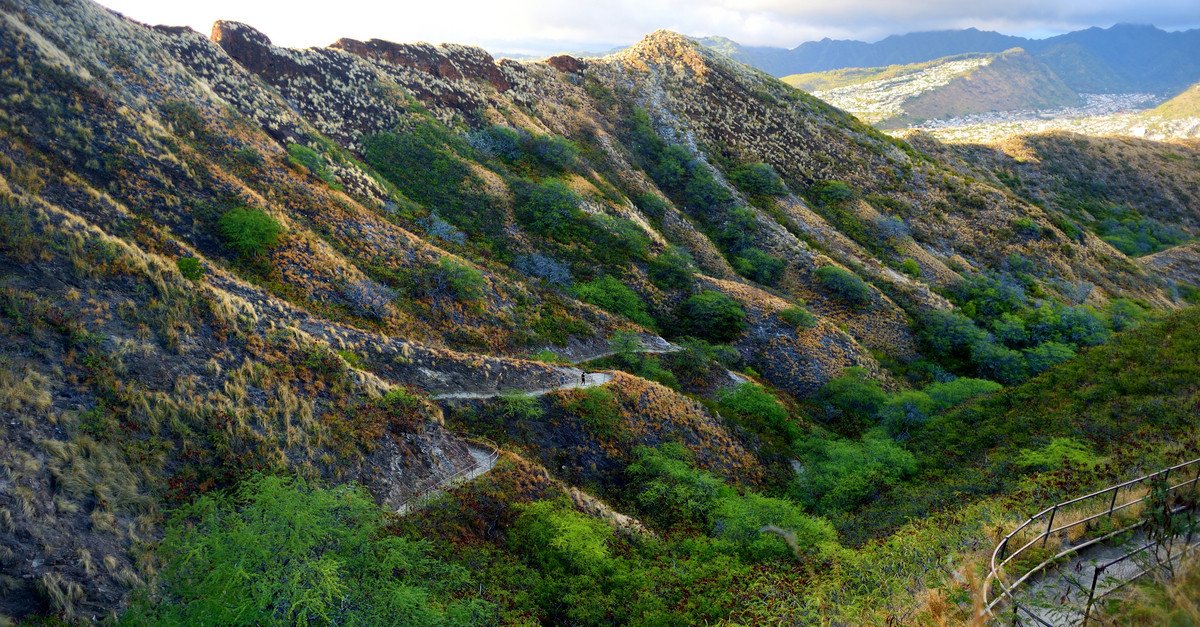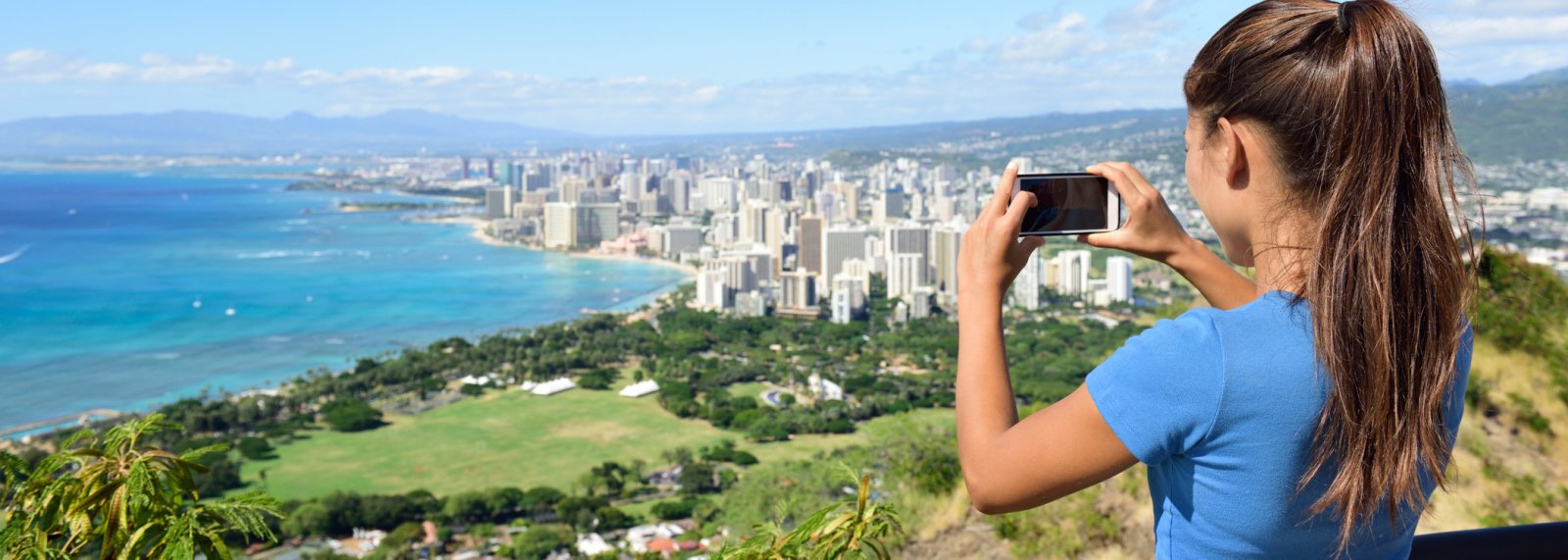11-07-2024
Diamond Head (Leahi) Hiking Trail
Located within the Waikiki & Honolulu Region on Oahu
Aloha! This article may link to trusted Hawaii resources at no extra cost to you. Mahalo for your support!
Diamond Head Hike
Oahu Hiking Trail
The trail to the summit of Diamond Head (Hawaiian name Le’ahi), near Waikiki, was built in 1908 as part of the U.S. Army Coastal Artillery defense system.
Entering the crater from Fort Ruger, through the Kapahulu Tunnel, the trail scaled the steep western interior slopes of the crater to the summit. The dirt trail with numerous switchbacks was designed for mule and foot traffic. Prior to WWI, the mules hauled materials on this trail for the construction of a Fire Control Station at the summit, which still stands today, and the top of the tower offers extensive and sweeping views of southeastern O’ahu.
The area has been shaped by a dynamic geological history. Diamond Head Crater, which is a ‘tuff cone’, was formed 300 000 years ago when the southeastern end of the Ko’olau range erupted. The summit was used historically as a lookout during war times – both in Hawaiian culture and in more recent history. Culturally it was used to spot fleets of war canoes, as well as to guide friendly canoes from neighboring islands with bonfires lit along the south rim. Similarly, the U.S. government also recognized the advantage of strengthening coastal defenses and prior to WWI purchased Diamond Head to develop a military reservation in 1904. The trail features many of the original bunkers, tunnels, and infrastructure that was built during this time.
From the trailhead to the summit of Diamond Head Crater, it is 0.8miles (1.3km) one way, and it is a 560 foot (171m) climb from the crater floor. Allow 1.5-2 hours for a safe and leisurely round-trip hike. The trail follows an uneven and at times steep terrain, and caution as well as appropriate footwear are required. The hike begins as a concrete pathway then becomes a dirt path about halfway. Initially, the well-paved trail winds its way through spindly haole koa forest until the base of a set of switchbacks where you can begin to see views of the crater. At the top of the switchbacks is a lookout with the best view along the trail so far, and a nice spot to stop and take a water break. Here you are standing on a concrete landing built in pre-war times. You can see the remains of a winch and cable, which was built to lift materials from the crater floor.
As of April 19, 2021, All non-Hawaii resident visitors to Diamond Head State Monument will be required to purchase both Entrance and Parking unless arriving on-foot. Children 3 and under are free. Parking and Entry for Hawaii residents is free with Hawaii ID or Hawaii Driver License. Paid Entry and Parking by CREDIT CARD ONLY,
Entry fee (non-resident): $5 per person.
Parking fee (non-resident): $10 per vehicle.
Non-Resident Reservations Required
The State of Hawaii’s Department of Land and Natural Resources (DLNR) announced in late April 2022, that advanced reservations will be required for out-of-state visitors at Le`ahi - Diamond Head State Monument, beginning May 12, 2022. The implementation of this system delivers on one of the top priorities of the community as articulated in the updated Oʻahu Destination Management Action Plan. The new reservation system will mitigate environmental impacts sustained by foot traffic, reduce vehicle congestion in the park and surrounding neighborhoods, improve the experience of kamaʻāina and visitors enjoying the monument, and help preserve this landmark for future generations.
Visitors parking vehicles in the crater will be required to book in two-hour time slots beginning at 6 a.m. (two consecutive slots can be booked). Walk-in and drop-off visitors will be subject to one-hour entry time slots. Arrival and exit times will be enforced to assure adequate turnover to allow for later arrivals. Park hours and visitor entrance fees are available at Hawaii DLNR.

The Hiking Trails of Diamond Head Crater
Grab Your Free Travel Guides!
Oahu Intro Visitor Guide
+ Our Summary Guidesheet!
Includes the top must-see & do attractions, best times to visit, a monthly weather & visitor summary, and our tips on how to save when booking your car rental, tours, and activities. Plus, grab our free Oahu Summary Guidesheets. Check out our Updated Oahu Visitor Guides.
After a couple more switchbacks, the trail then climbs 74 steps and meanders through a long, narrow, curving tunnel. At the end of that tunnel (which is lighted), there are two routes to the summit. You can choose to go straight up a steep set of stairs (99 steps) and through a short tunnel, into the base of the large Fire Control Station and then up a spiral staircase (52 steps) to the top. Alternatively, you can follow the path to the left and up a slightly more gradually inclining staircase (82 steps) to the top where there are fabulous views of Hawaii Kai towards Makapu’u and then up another stairway (54 steps) to end up at the same final destination as the other route, with extensive 360-degree views of Waikiki, Honolulu and surrounding area. From here you can clearly view the bunkers situated along the crater rim that was built in 1915. There are also sweeping views of the southeastern Oahu coastline towards Koko Head and the offshore islands of Moloka’i, Lana’i, and Maui. The elevation at the summit is 761 feet (232m).
- Stay hydrated and take it slowly – the trail is very exposed and hot.
-
For more information, including hours, visit: Department of Land and Natural Resources
Directions
Exit Waikiki and travel to Diamond Head (east) on Kalakaua Avenue. As you cross Kapahulu Avenue continue straight, then take the left fork, which is Monsarrat Avenue. Continue straight until it becomes Diamond Head Road. The access road to Diamond Head crater will be on your right, just across from Kapiolani Community College.

Reaching the summit at Diamond Head Crater
You May Also be Interested In
Diamond Head (Leahi) Hiking Trail Reviews
Guidereview:
A (based on 9,394 visitor reviews)Geolocation Data
Geographic Coordinates
Latitude: 21.262923373213
Longitude: -157.80411924866
Hawaii Safety Information
Recommended Tours Nearby
Affiliate Disclosure: We may earn commissions from some travel partners (like Amazon or Expedia) which helps us maintain this site. These links are at no extra cost to you and don't impact our honest & unbiased recommendations. Remove all the ads →




